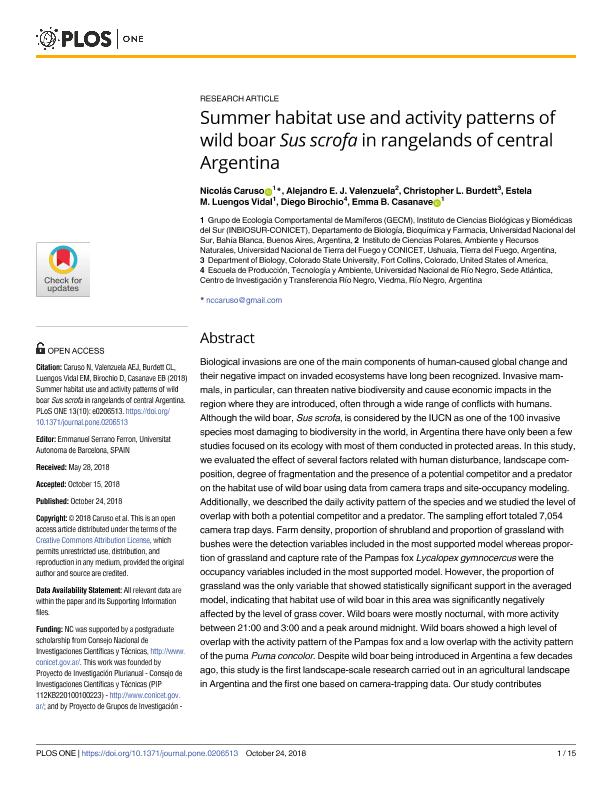Mostrar el registro sencillo del ítem
dc.contributor.author
Caruso, Nicolás

dc.contributor.author
Valenzuela, Alejandro Eduardo Jorge

dc.contributor.author
Burdett, Christopher L.
dc.contributor.author
Luengos Vidal, Estela Maris

dc.contributor.author
Birochio, Diego Enrique

dc.contributor.author
Casanave, Emma Beatriz

dc.date.available
2019-11-04T19:02:43Z
dc.date.issued
2018-10-24
dc.identifier.citation
Caruso, Nicolás; Valenzuela, Alejandro Eduardo Jorge; Burdett, Christopher L.; Luengos Vidal, Estela Maris; Birochio, Diego Enrique; et al.; Summer habitat use and activity patterns of wild boar Sus scrofa in rangelands of central Argentina; Public Library of Science; Plos One; 13; 10; 24-10-2018; 1-15
dc.identifier.issn
1932-6203
dc.identifier.uri
http://hdl.handle.net/11336/87951
dc.description.abstract
Biological invasions are one of the main components of human-caused global change and their negative impact on invaded ecosystems have long been recognized. Invasive mammals, in particular, can threaten native biodiversity and cause economic impacts in the region where they are introduced, often through a wide range of conflicts with humans. Although the wild boar, Sus scrofa, is considered by the IUCN as one of the 100 invasive species most damaging to biodiversity in the world, in Argentina there have only been a few studies focused on its ecology with most of them conducted in protected areas. In this study, we evaluated the effect of several factors related with human disturbance, landscape composition, degree of fragmentation and the presence of a potential competitor and a predator on the habitat use of wild boar using data from camera traps and site-occupancy modeling. Additionally, we described the daily activity pattern of the species and we studied the level of overlap with both a potential competitor and a predator. The sampling effort totaled 7,054 camera trap days. Farm density, proportion of shrubland and proportion of grassland with bushes were the detection variables included in the most supported model whereas proportion of grassland and capture rate of the Pampas fox Lycalopex gymnocercus were the occupancy variables included in the most supported model. However, the proportion of grassland was the only variable that showed statistically significant support in the averaged model, indicating that habitat use of wild boar in this area was significantly negatively affected by the level of grass cover. Wild boars were mostly nocturnal, with more activity between 21:00 and 3:00 and a peak around midnight. Wild boars showed a high level of overlap with the activity pattern of the Pampas fox and a low overlap with the activity pattern of the puma Puma concolor. Despite wild boar being introduced in Argentina a few decades ago, this study is the first landscape-scale research carried out in an agricultural landscape in Argentina and the first one based on camera-trapping data. Our study contributes valuable information that could be used to design strategies to reduce wild boar population or to minimize the damage caused by this invasive species in Argentina.
dc.format
application/pdf
dc.language.iso
eng
dc.publisher
Public Library of Science

dc.rights
info:eu-repo/semantics/openAccess
dc.rights.uri
https://creativecommons.org/licenses/by/2.5/ar/
dc.subject
BIOLOGICAL INVASIONS
dc.subject
ESPINAL
dc.subject
FERAL HOG
dc.subject
INTERACTIONS
dc.subject.classification
Conservación de la Biodiversidad

dc.subject.classification
Ciencias Biológicas

dc.subject.classification
CIENCIAS NATURALES Y EXACTAS

dc.title
Summer habitat use and activity patterns of wild boar Sus scrofa in rangelands of central Argentina
dc.type
info:eu-repo/semantics/article
dc.type
info:ar-repo/semantics/artículo
dc.type
info:eu-repo/semantics/publishedVersion
dc.date.updated
2019-10-17T14:03:12Z
dc.journal.volume
13
dc.journal.number
10
dc.journal.pagination
1-15
dc.journal.pais
Estados Unidos

dc.journal.ciudad
San Francisco
dc.description.fil
Fil: Caruso, Nicolás. Consejo Nacional de Investigaciones Científicas y Técnicas. Centro Científico Tecnológico Conicet - Bahía Blanca. Instituto de Ciencias Biológicas y Biomédicas del Sur. Universidad Nacional del Sur. Departamento de Biología, Bioquímica y Farmacia. Instituto de Ciencias Biológicas y Biomédicas del Sur; Argentina
dc.description.fil
Fil: Valenzuela, Alejandro Eduardo Jorge. Universidad Nacional de Tierra del Fuego; Argentina. Consejo Nacional de Investigaciones Científicas y Técnicas; Argentina
dc.description.fil
Fil: Burdett, Christopher L.. State University of Colorado - Fort Collins; Estados Unidos
dc.description.fil
Fil: Luengos Vidal, Estela Maris. Consejo Nacional de Investigaciones Científicas y Técnicas. Centro Científico Tecnológico Conicet - Bahía Blanca. Instituto de Ciencias Biológicas y Biomédicas del Sur. Universidad Nacional del Sur. Departamento de Biología, Bioquímica y Farmacia. Instituto de Ciencias Biológicas y Biomédicas del Sur; Argentina
dc.description.fil
Fil: Birochio, Diego Enrique. Universidad Nacional de Río Negro; Argentina
dc.description.fil
Fil: Casanave, Emma Beatriz. Consejo Nacional de Investigaciones Científicas y Técnicas. Centro Científico Tecnológico Conicet - Bahía Blanca. Instituto de Ciencias Biológicas y Biomédicas del Sur. Universidad Nacional del Sur. Departamento de Biología, Bioquímica y Farmacia. Instituto de Ciencias Biológicas y Biomédicas del Sur; Argentina
dc.journal.title
Plos One

dc.relation.alternativeid
info:eu-repo/semantics/altIdentifier/url/https://journals.plos.org/plosone/article?id=10.1371/journal.pone.0206513
dc.relation.alternativeid
info:eu-repo/semantics/altIdentifier/doi/http://dx.doi.org/10.1371/journal.pone.0206513
Archivos asociados
